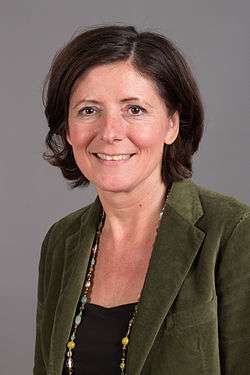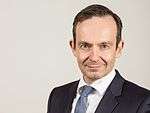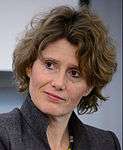Rhineland-Palatinate state election, 2016
| |||||||||||||||||||||||||||||||||||||||||||||||||||||||||||||||||||||||||||||||||||||||||||||
All 101 seats of the Landtag of Rhineland-Palatinate. 51 seats needed for a majority | |||||||||||||||||||||||||||||||||||||||||||||||||||||||||||||||||||||||||||||||||||||||||||||
| Turnout | 70.4 % | ||||||||||||||||||||||||||||||||||||||||||||||||||||||||||||||||||||||||||||||||||||||||||||
| |||||||||||||||||||||||||||||||||||||||||||||||||||||||||||||||||||||||||||||||||||||||||||||
| |||||||||||||||||||||||||||||||||||||||||||||||||||||||||||||||||||||||||||||||||||||||||||||
The 2016 Rhineland-Palatinate state election was held on 13 March 2016 to elect all 101 members to the Landtag of Rhineland-Palatinate. Seats are allotted by proportional representation with a 5% threshold. State elections were held on the same day in Baden-Württemberg and Saxony-Anhalt.
After the election, Malu Dreyer of the Social Democratic Party led a coalition government of her party with Greens and Free Democratic Party, nicknamed the "traffic light coalition".
Polls
The reference for the polls is wahlrecht.de.[2]
| Poll | Date | SPD | CDU | Green | FDP | Left | FW | Pirate | AfD | Other |
|---|---|---|---|---|---|---|---|---|---|---|
| Forschungsgruppe Wahlen[3] | 03/10/2016 | 36% | 35% | 5.5% | 7% | 3% | – | – | 9% | 4.5% |
| YouGov[3] | 03/10/2016 | 35% | 36% | 6% | 6% | 4% | – | – | 11% | 2% |
| Forsa[3] | 03/09/2016 | 35% | 35% | 6% | 6% | 4% | – | – | 9% | 5% |
| INSA[3] | 03/07/2016 | 35% | 35% | 7% | 5% | 3% | – | – | 9% | 6% |
| Forschungsgruppe Wahlen[3] | 03/04/2016 | 34% | 35% | 6% | 6% | 4% | – | – | 10% | 5% |
| Infratest dimap[3] | 03/03/2016 | 34% | 36% | 7% | 5% | 4% | – | – | 9% | 5% |
| Infratest dimap[3] | 03/01/2016 | 32% | 36% | 8% | 6% | 4% | – | – | 9% | 5% |
| INSA[3] | 02/28/2016 | 32.5% | 35% | 10% | 6% | 4% | – | – | 8.5% | 4% |
| GESS Phone & Field[3] | 02/25/2016 | 33% | 37% | 8% | 5% | 3% | 2% | – | 9% | 3% |
| INSA[3] | 02/22/2016 | 33% | 35% | 9% | 7% | 4% | – | – | 8.5% | 3.5% |
| Infratest dimap[3] | 02/11/2016 | 31% | 37% | 8% | 6% | 4% | – | – | 9% | 5% |
| INSA[3] | 02/05/2016 | 32% | 36% | 10% | 6% | 3% | – | – | 8% | 5% |
| Forschungsgruppe Wahlen[3] | 01/22/2016 | 31% | 38% | 7% | 5% | 5% | – | – | 9% | 5% |
| Infratest dimap[3] | 01/14/2016 | 31% | 37% | 9% | 5% | 5% | – | – | 8% | 5% |
| Infratest dimap[3] | 12/10/2015 | 31% | 39% | 9% | 5% | 5% | – | – | 7% | 4% |
| INSA[3] | 11/25/2015 | 31% | 38.5% | 11% | 4.5% | 3.5% | 2.5% | – | 7% | 2% |
| GESS Phone & Field[3] | 11/19/2015 | 33% | 40% | 9% | 5% | 3% | 2% | – | 5% | 3% |
| Forschungsgruppe Wahlen[3] | 11/06/2015 | 30% | 41% | 8% | 4% | 5% | – | – | 6% | 6% |
| Infratest dimap[3] | 09/24/2015 | 31% | 41% | 10% | 5% | 5% | – | – | 4% | 4% |
| Infratest dimap[3] | 07/23/2015 | 33% | 42% | 10% | 4% | 3% | – | – | 3% | 5% |
| GESS Phone & Field[3] | 06/26/2015 | 33% | 40% | 11% | 4% | 3% | 2% | – | 4% | 2% |
| Infratest dimap[3] | 02/19/2015 | 32% | 42% | 11% | 3% | 3% | – | – | 5% | 4% |
| GESS Phone & Field[3] | 12/17/2014 | 30% | 43% | 10% | 3% | 4% | 1% | 1% | 5% | 3% |
| Infratest dimap[3] | 11/13/2014 | 31% | 43% | 11% | 2% | 4% | – | – | 5% | 4% |
| Infratest dimap[3] | 09/25/2014 | 31% | 43% | 10% | 2% | 4% | – | – | 6% | 4% |
| GESS Phone & Field[3] | 06/24/2014 | 32% | 41% | 10% | 3% | 4% | 2% | – | 4% | 4% |
| Infratest dimap[3] | 05/08/2014 | 31% | 41% | 11% | 3% | 4% | – | – | 4% | 6% |
| Infratest dimap[3] | 04/03/2014 | 33% | 41% | 11% | 3% | 4% | – | – | 3% | 5% |
| State election 2011[3] | 03/27/2011 | 35.7% | 35.2% | 15.4% | 4.2% | 3.0% | 2.3% | 1.6% | N/A | 2.5% |
Results
< 2011 ![]() < 2021
< 2021
| Party | Popular vote | Seats | ||||||||
|---|---|---|---|---|---|---|---|---|---|---|
| Votes | % | +/– | Seats | +/– | ||||||
| Social Democratic Party Sozialdemokratische Partei Deutschlands – SPD|| 771,848 | 36.2 | | 39 | | ||||||
| Christian Democratic Union Christlich Demokratische Union Deutschlands – CDU|| 677,507 | 31.8 | | 35 | | ||||||
| Alternative for Germany Alternative für Deutschland – AfD|| 268,628 | 12.6 | | 14 | | ||||||
| Free Democratic Party Freie Demokratische Partei – FDP|| 132,294 | 6.2 | | 7 | | ||||||
| Alliance '90/The Greens Bündnis 90/Die Grünen|| 113,261 | 5.3 | | 6 | | ||||||
| The Left Die Linke|| 59,970 | 2.8 | | – | – | ||||||
| Free Voters Rhineland-Palatinate Freie Wähler | 47,924 | 2.2 | | – | – | |||||
| Pirate Party Piratenpartei|| 16,708 | 0.8 | | – | – | ||||||
| Alliance for Progress and Renewal Allianz für Fortschritt und Aufbruch – ALFA|| 13,154 | 0.6 | | – | – | ||||||
| National Democratic Party Nationaldemokratische Partei Deutschlands – NPD|| 10,565 | 0.5 | | – | – | ||||||
| Ecological Democratic Party Ökologisch-Demokratische Partei – ÖDP|| 8,623 | 0.4 | | – | – | ||||||
| The Republicans Die Republikaner – REP|| 5,090 | 0.2 | | – | – | ||||||
| The Unity Die Einheit | 3,105 | 0.1 | | – | – | |||||
| The Third Way Der III. Weg | 1,944 | 0.1 | | – | – | |||||
| Other parties | – | – | – | – | – | |||||
| Valid votes | 2,130,621 | 98.6 | |
|||||||
| Invalid votes | 30,885 | 1.4 | | |||||||
| Totals and voter turnout | 2,161,506 | 70.4 | |
101 | – | |||||
| Electorate | 3,071,972 | 100.0 | — | |||||||
| Source: Landeswahlleiter[4] | ||||||||||
Post-election

A coalition of the existing ruling parties, the SPD and the Greens, would not have sufficient votes in the Landtag to be able to muster a majority (they would have 45 seats – 7 short of a majority). Neither would a coalition of the CDU and the returning FDP (they would have 42 seats – 10 seats short). A große Koalition (‘grand coalition’) of the SPD and CDU would have an absolute majority of 22 seats, but with the SPD having ruled out a grand coalition with Klöckner and the CDU ahead of the election, Dreyer looks most likely to work towards a "traffic light coalition," which would see the SPD, Free Democrats (FDP), and Greens join forces. These three parties would be able to form a state government with the SPD holding 39 seats, the Greens 6, and the FPD 7 – this would have a bare majority of 1 vote (52 seats) in the Landtag. A "Jamaica Coalition" of the CDU, FDP, and Greens would fall 4 seats short of the necessary majority. An unlikely, although theoretically possible, coalition between the CDU and AfD would also fall short by 3 seats in the Landtag.
Alternatively, a minority government of the SPD and Greens could take power with the "toleration" of the FDP and/or the CDU, or a FDP/SPD coalition with the toleration of the Greens and/or CDU. This has not had much of a precedent in western Germany, but is entirely possible.[5]
Eventually, a traffic-light coalition between the SPD, The Greens and the FDP was formed, and Malu Dreyer remained the minister-president.
References
- ↑ Greens MP Rahim Schmidt left his party in 2015 and has since been an independent member of the Landtag. "Abgeordneter verlässt die Grünen" (in German). SWR. 30 September 2015. Retrieved 13 March 2016.
- ↑ "Umfragen Rheinland-Pfalz". wahlrecht.de. Retrieved 30 January 2016.
- 1 2 3 4 5 6 7 8 9 10 11 12 13 14 15 16 17 18 19 20 21 22 23 24 25 26 27 28 29 Wahlumfragen zur Landtagswahl in Rheinland-Pfalz
- ↑ "Landesergebnis Rheinland-Pfalz – Endgültiges Ergebnis" (in German). Landeswahlleiter Rheinland-Pfalz. 13 March 2016. Retrieved 13 March 2016.
- ↑ http://www.dw.com/en/rhineland-palatinate-plays-it-safe-re-electing-spd-for-sixth-consecutive-term/a-19112416





